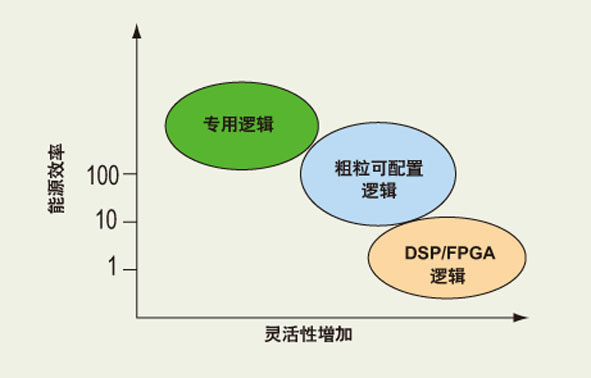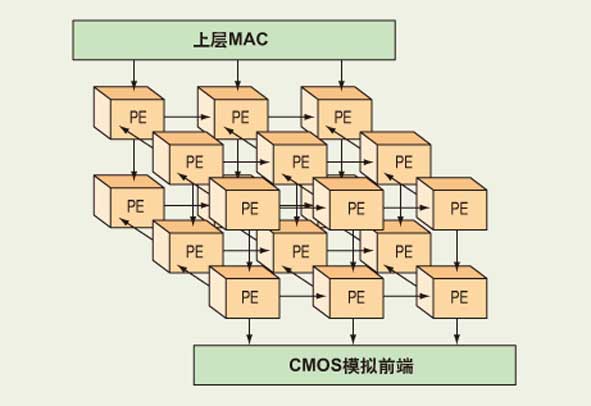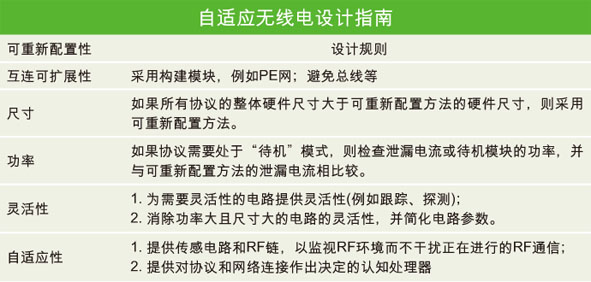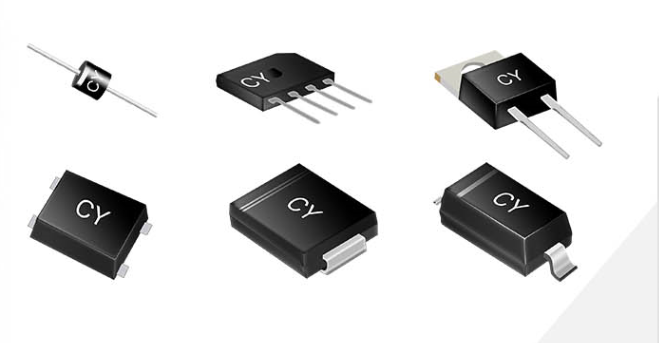Today, people may carry more than one cell-phone, Wi-Fi card, laptop with network adapter (NIC), Bluetooth-enabled PDA, and GPS device in the car. But in the end people will want to integrate all communication devices into one smart device.
Adaptive radios use one device to communicate with all devices operating within these frequency bands with appropriate protocols. When the device starts communicating, the adaptive wireless sensor measures its environment and selects the best available frequency band. During transmission and reception, it may change the protocol and frequency band several times to ensure a reliable high-speed connection. In a system that fully implements this vision, the cost of paying for these services can be concentrated into monthly bills, and customers no longer have to care about which protocol or technology is handling their wireless communications.
Intel Corporation has been working hard to develop hardware and software building blocks necessary for implementing adaptive communications. The goal is to build inexpensive silicon components and software modules for adaptive smart devices. Many innovative technologies have been developed today, but there are still some obstacles to this vision.
Spectrum allocation method
The biggest obstacle to adaptive radio is policy issues, not technical challenges. For the implementation of crossover technology, the spectrum resources allocated for large-scale high-speed wireless communications are far from enough. This problem is largely due to a long-standing policy of allocating fixed frequency bands to dedicated communications.
For example, a fixed frequency band allocated to a television channel can only be used by a grantee. When the transferee is not using, the channel bandwidth is idle and other devices are not allowed to use. Similarly, TV channels that are not allocated in a specific area cannot be used by other devices and cannot even be used by other television broadcasting devices in the same area. Therefore, these channels are always in an unused state. In addition, there are still unused spectrums between channels. The reason why there is a large amount of unused bandwidth area is that the transmission power of each television broadcasting device is high and may interfere with each other. Under certain circumstances, it is not possible for a television tuner to clearly receive broadcast signals unless there is a wide spectral separation between the respective transmission channels. On the UHF band, this spectrum interval includes many television channels, which are called "disabled channels."
The spectrum allocation approach may evolve from the existing fixed bandwidth allocation to a distribution based on a certain rule. Multiple users can access unoccupied bandwidth without disturbing the primary user (in principle). This solution, known as the "overlay method," superimposes a shared secondary communication channel on the existing allocated primary user bandwidth. This kind of sharing is obtained through consultation on a voluntary basis and can be negotiated before use or during use. One example is the sharing that occurs between the frequency bands used by public safety agencies and television bands. In addition, low-power devices can operate near television broadcast stations without causing harmful interference.
The second solution is to make the currently used allocated bandwidth play a dual role. In this method, low-power transmitted signals exist on the same spectrum used by other devices, such as Wi-Fi and cordless phones. These transmit signals are only used for short-range communications in homes or small offices. Their bandwidth is very high (up to several gigahertz), so the power density in a given frequency band is very low. When these transmit signals overlap with other signals on the same frequency spectrum, they are noise to other devices. Using filtering techniques, the device can filter out these unwanted transmissions to avoid collisions.
The direct reason for the need for more bandwidth is the nature of adaptive communications. Considering that when a cellular system receives far more calls than it can handle, new calls will be rejected, so denying access saves bandwidth. Where adaptive radios are likely to switch to other channels, these bandwidths will be used to enable communication.
Another reason for the extra bandwidth required is the need for reliable, high-speed communications that are readily available. Of course, new applications will also need to use this bandwidth. For example, people will soon need to wirelessly transmit video and audio streams to entertainment centers and televisions throughout the rooms. The wired connection between the stereo and the microphone will become history, and the connection between the computer and the peripherals and the connection between the computing devices will also be eliminated. Each replaced wireless connection will consume spectral bandwidth.

Figure 1: The compromise between flexibility, energy efficiency, and dedicated logic, coarse grain reconfigurable logic, and DSP/FPGA logic.
Requirements for adaptive radios
Adaptive radios need to identify the environment they are in. They must be able to detect and identify the available frequency bands. They must then detect these channels and determine if interference, noise, and other factors will affect the signal quality. They must also identify existing networks that have been authorized and quickly connect with them to negotiate for the required data throughput.
After detecting this information, the adaptive radio must be able to analyze these channels, intelligently select the best channel, and determine the protocol and modulation mechanism that will be used. Finally, the equipment should be reconfigured itself to use the selected protocol and modulation technique in the appropriate frequency band.
Once the communication is established, the adaptive radio must continuously monitor the channel to detect if the signal quality has significantly decreased, or find a better available channel. If either of these two conditions is detected, the adaptive radio must seamlessly switch to the new frequency band and protocol. As a result, adaptive radios must seize opportunities in search and quickly reconfigure to take advantage of better channels.
The ability to seamlessly switch between frequency bands and protocols also means that the adaptive radio must be able to synchronize its configuration and connectivity to multiple radios. Therefore, adaptive radios are sometimes referred to as cognitive, reconfigurable radios.
Most networking devices (such as NICs and Wi-Fi devices) are built to meet a well-defined, narrowly defined range of requirements, that is, to use one protocol to communicate on one channel at the lowest possible cost. Some adaptive techniques have been used for wireless connections, such as determining the best data rate for communications, although there is no protocol/network switch. These less flexible devices typically use dedicated hardware.
But by using DSPs and ASICs, you can gain some flexibility. The DSP processes the signal and offloads some of the protocol processing algorithms into the ASIC. Other designs use DSPs that are tightly coupled to the accelerator. However, DSPs require a lot of power, and this type of radio may also require multiple DSPs. All of the previously mentioned devices prefer a simple antenna-PHY-MAC hardware architecture that is mature and well understood.
Software solutions that use a reconfigurable processor to handle the necessary protocols have not been seen as a viable alternative. This processor does not have the basic processing capabilities, or it can't reconfigure itself quickly when dealing with a working communication protocol. However, as ICs continue to evolve based on Moore's Law, the ability to reconfigure processors to execute complex algorithms in real time has greatly increased. These adaptive radios will increase the efficiency of spectrum utilization because they can make better use of unoccupied spectrum and can determine the best spectrum with changes in time, space, and frequency bands. This will give the user better communication quality.

Figure 2: The reconfigurable PE network forms the core of the adaptive radio.
Reconfigurable communication core
Research into the silicon building blocks of adaptive radios includes prototype radios, which consist of a heterogeneous set of processing units (PEs) with multiple routable paths between them. Many researchers choose the same type of array with great flexibility, and use an arithmetic logic unit (ALU) and processor at each node.
These arrays usually endure the ALU and the processor to handle decoding and relay instruction requests every clock cycle. Due to their versatility and flexibility, they require a considerable amount of memory and clock cycles to correctly calculate a specific function. Their cost in size and power is several orders of magnitude higher than dedicated logic (see Figure 1). The dedicated logic only handles one protocol, but coarse-grain reconfigurable logic and DSP/FPGA logic can support multiple protocols. Of course, the difference between the two is that the DSP/FPGA logic can handle any transaction, but this great flexibility also brings huge power consumption.
The Reconfigurable Communication Core (RCC) was developed after extensive investigation of a variety of wireless protocols and identifying similar, computationally burdensome processing cores. Subsequently, dedicated reconfigurable accelerators that are much thicker than the FPGA architecture are designed to perform these functions. From an optimal point of view, these functions are only reconfigured once. The purpose is to avoid reconfiguring each function that will be executed one clock cycle after another clock cycle, and the data is “streamed†and “flowed†from these PEs. Out. Processing occurs in both space and time, and a significant portion of processing is performed in parallel in space.
The as much processing similarity between dedicated hardware processing (spatially completely parallel) is used as much as possible, while time division multiple access techniques are only used when the frequency band is as much as the semiconductor process allows. Therefore, the processing band is not tied to multiple A/D converter rates, just like dedicated hardware. One advantage of doing so is that the area can be saved, thereby reducing the increase in area due to reconfigurability. Architectures such as RCC have features that are close to the power/size of dedicated hardware while maintaining enough reconfigurability to support most wireless protocols.
For example, these PEs are similar to filter-microcoded accelerators, forward error correction (FEC) accelerators with additional interface elements, and elements that control processing elements. By simply controlling the routing of data packets between different PEs and reconfiguring the PE, the radio can be reconfigured for multiple protocols itself.
This reconfigurable approach saves power and size compared to alternatives to multiple dedicated cores and other software-defined radio methods. In addition, reconfigurable methods have decisive advantages that are easier to program, as well as better portability and component extensibility, in order to use existing tools for other platforms and future protocols. Extensibility is achieved through the "building block" grid connection. This makes it possible to establish a connection between "new elements" and their associated communication infrastructure (such as routing nodes, etc.), similar to the new roads that are added when building more houses in a cell (see Figure 2). These new "roads" or interconnection infrastructures will not affect the existing infrastructure. This architecture is based on the fact that for communication physical layer (PHY) applications, operations are highly pipelined, and most of the time, they only need to communicate with the nearest neighbor processing unit. If interconnect blocking occurs on a very large processing unit network, it is easy to add a choice to add a simple hierarchy to the interconnect architecture.

Continuing research is driving further componentization of adaptive radio units. The goal is to make them effective enough and cheap enough to become the standard solution for continuous, high quality wireless communications in homes, workplaces, and on the road. However, to make this vision a reality, it will also need to modify the spectrum allocation policy so that all possible bandwidth can be used for continuous communications. The table lists adaptive radio design guidelines.
Advances in technology have made it possible to use spectrum more efficiently and have influenced the reform of spectrum allocation policies. The existing work on cognitive, reconfigurable radio research will allow ubiquitous wireless communications to span multiple protocols, networks, and spectrums.
Superfast Recovery Rectifier is the most popular use for diodes. Fast rectifiers convert alternating current (AC) to direct current (DC). They only allow one-way flow of electrons. Rectifiers have many uses and are often found serving as components of high-voltage direct current power transmission systems and DC power supplies. Fast rectifier diodes feature very low reverse recovery time, very low switching losses and low noise turn-off switching.

Super Fast Rectifiers,Fast Recovery Rectifiers,Super Fast Recovery Rectifier,Ultra Fast Rectifier Diodes
Changzhou Changyuan Electronic Co., Ltd. , https://www.changyuanelectronic.com
